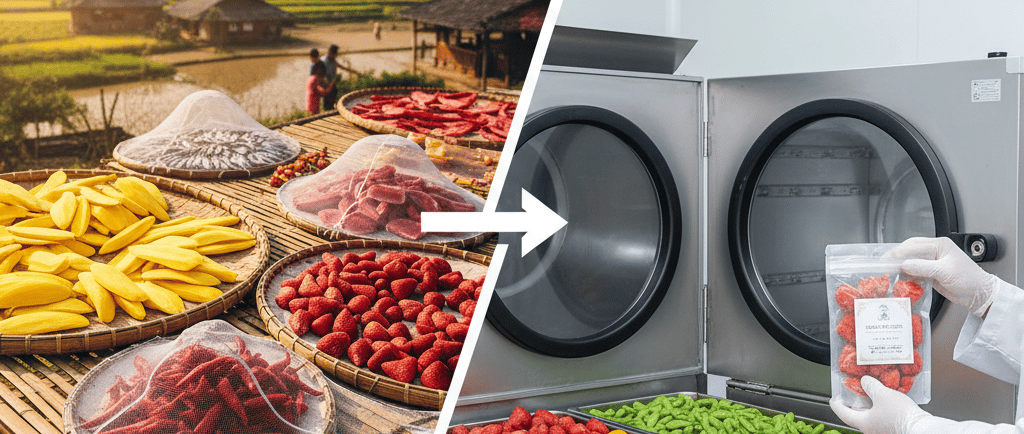Comparing Drying Methods: Why Freeze-Drying Stands Out in the Asian Market
This article compares food drying methods in Asia, highlighting why freeze-drying excels in preserving nutrition, flavor, and shelf life for modern and premium markets.
BUSINESSFREEZE DRIED FRUITSHEALTHFREEZE DRYSOUTH EAST ASIANASIAN FOODSFREEZE DRIED SNACKSTEXTUREFREEZE DRIED PRODUCTSFOOD WASTEASIAFREEZE DRIED FOODSFREEZE DRYINGEXOTIC FRUITSFREEZE-DRIED PRODUCT SUPPLIERSFOOD PRESERVATIONDEHYDRATEDPRODUCTIONTECHNOLOGYNUTRITION
10/9/20253 min read


Comparing Drying Methods: Why Freeze-Drying Stands Out in the Asian Market
Asia, a vast and diverse continent encompassing Central, East, South, Southeast, and Western Asia, has a rich history of food preservation, largely relying on traditional methods like sun-drying, air-drying, and fermentation. While these techniques remain essential, the modern market's need for maximum nutrition, extended shelf life, and superior quality is increasingly highlighting freeze-drying as the superior food preservation method.
A Look at Traditional and Conventional Methods
Across Asia, preserving food is critical due to seasonal harvests and the need to transport food in varying climates. The primary conventional drying methods are:
* Sun-Drying / Air-Drying: This oldest technique uses natural heat and air to remove moisture. It is low-cost and sustainable, making it popular for fruits, vegetables, and fish.
* Drawbacks: The process is slow and open to contaminants. The high heat can destroy sensitive vitamins (like Vitamin C), and the final product often becomes leathery, chewy, and significantly shrunken, altering the original flavor. The shelf life is moderate, typically 1 to 5 years.
* Dehydration (Hot Air Drying): This uses heated air in a controlled machine. It's faster than sun-drying but still relies on high temperatures.
* Drawbacks: Similar to sun-drying, the heat leads to a loss of heat-sensitive nutrients and can change the food's texture and color. The moisture removal is around 90–95%, which isn't enough for maximum long-term storage.
The Freeze-Drying Advantage: Preservation Perfected
Freeze-drying (or lyophilization) is a process that avoids high heat entirely. It involves freezing the food and then placing it in a vacuum chamber, where the ice turns directly into vapor (sublimation). This unique, low-temperature, low-pressure process makes it stand out:
1. Superior Quality and Retention
* Maximum Nutrient Retention: Because no heat is used, freeze-drying retains up to 97% of the food's original nutritional value, including heat-sensitive vitamins and enzymes. This is a major selling point in health-conscious Asian markets, where consumers value the natural benefits of food.
* Original Taste, Color, and Shape: The structure of the food doesn't collapse during the process. The resulting product is light and porous, maintaining its original shape, color, and flavor better than any other drying method. This is crucial for premium snacks and ingredients.
* Rapid Rehydration: Freeze-dried foods rehydrate almost instantly when water is added, returning to a texture very close to fresh food. This offers superior convenience compared to the long soaking times often required for conventionally dehydrated goods.
2. Unmatched Shelf Life and Safety
* Extreme Shelf Life: Freeze-drying removes up to 99% of the moisture, creating an environment where bacteria, mold, and yeast cannot grow. When properly sealed, the food can be stored for 15 to 25 years without refrigeration. This offers unmatched food security for consumers, military/emergency rations, and long-term pantry stocking.
* Lightweight for Transport: By removing almost all the water, the food becomes extremely light and compact. This significantly reduces shipping and storage costs, which is a considerable advantage for distribution across the vast geographic regions of Asia.
Key Applications in the Asian Market
The unique benefits of freeze-drying make it an ideal fit for several growing sectors across the Asian market:
1. Premium and Convenience Snacks
The demand for healthy, on-the-go snacks is booming in urbanized parts of East and Southeast Asia. Freeze-dried fruits (like durian, jackfruit, and mango), yogurt melts, and vegetable crisps are marketed as high-value, preservative-free alternatives to processed snacks.
2. Instant and Ready-to-Eat (RTE) Meals
Freeze-drying is perfect for creating instant meal components, such as:
* Instant Coffee: It preserves the complex flavor of premium coffee beans better than spray drying.
* Instant Soups and Noodles: Freeze-dried meat, vegetables, and herbs in noodle packets offer superior quality and faster rehydration than air-dried ingredients. This convenience appeals to the busy working populations in countries like China, Japan, and South Korea.
3. High-Value Agricultural Products
For high-value, seasonal, or delicate Asian ingredients, like medicinal mushrooms (e.g., Cordyceps), herbs, and spices, freeze-drying preserves the bioactive compounds and command a premium price. This adds significant value to agricultural exports from South and Central Asia.
The Future is Freeze-Dried
While the high initial cost of equipment and energy consumption for freeze-drying remains a challenge compared to simple air-drying, the market growth in Asia is robust. Consumers are willing to pay a premium for superior nutrition, flavor, and convenience. With urbanization, rising incomes, and a greater focus on healthy and long-lasting foods, freeze-drying is poised to solidify its position as the gold standard for food preservation in the diverse and dynamic Asian market.
Quality
Premium freeze-dried products for healthy snacks and long-term storage.
Innovation
Sustainability
© 2024. All rights reserved.
